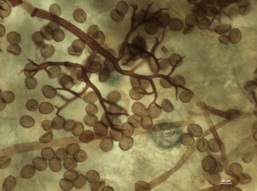I can see clearly now: A new method for rapid detection and identification of downy mildew in basil

Downy mildew (Pernospora belbahrii Thines) is a relatively new disease to North America. First reported in 1933 in Uganda, downy mildew has spread rapidly across the globe. Early detection of downy mildew is crucial for control of the disease, which can devastate both greenhouse and field basil crops. However, the signs and symptoms of basil downy mildew can be difficult to differentiate from those caused by environmental stresses such as nutrient deficiency. As part of an ongoing project to develop downy mildew–resistant plants, researchers at The City University of New York and Rutgers, The State University of New Jersey, have developed a novel procedure that enables early detection and identification of downy mildew in basil.
Removing the need for expensive equipment and complicated protocols, lead author Professor Adolfina Koroch and colleagues describe their method for detecting basil downy mildew in the July issue of Applications in Plant Sciences.
"Our protocol will be really important to help prevent the further spread of the disease," said Koroch. "This staining method will allow for quick identification of the pathogen at the early stages of the infection cycle. With this information, timely disease control measures can be taken so the pathogen spread can be diminished."
Using fresh leaf tissue, samples are rapidly cleared of their cellular contents with a proprietary new formulation called Visikol™. Visikol was first published in the May issue of Applications in Plant Sciences, where Koroch, along with graduate student Thomas Villani and Professor James Simon, demonstrated that the new solution is an effective substitute for the controlled substance chloral hydrate. Once cleared, tissue samples are stained and examined.
"What is so useful about this staining technique is that now downy mildew can be detected using a hand magnifying glass," said Villani. "Putting this protocol into practice, we are really excited about the effect that this will have on people in the industry, who often have to rely on macroscopic techniques."
This technique will allow growers, breeders, disease managers, county agents, and other labs to confirm the disease more rapidly so other control measures can be properly instituted. Expediting the diagnosis of basil downy mildew will facilitate rapid and appropriate control strategies that can be used to prevent disease epidemics and to help gardeners, growers, and educators alike in the proper identification of the pathogen. Although Koroch and her colleagues focused on the identification of basil downy mildew, they expect that their rapid staining protocol will aid the detection of other pathogenic organisms that cause disease outbreaks in other economically important plants.
"Science should be useful and translational," said Simon. "And that's exactly that this protocol allows us to do."
More information: www.bioone.org/doi/pdf/10.3732/apps.1300032
Journal information: Applications in Plant Sciences
Provided by American Journal of Botany


















